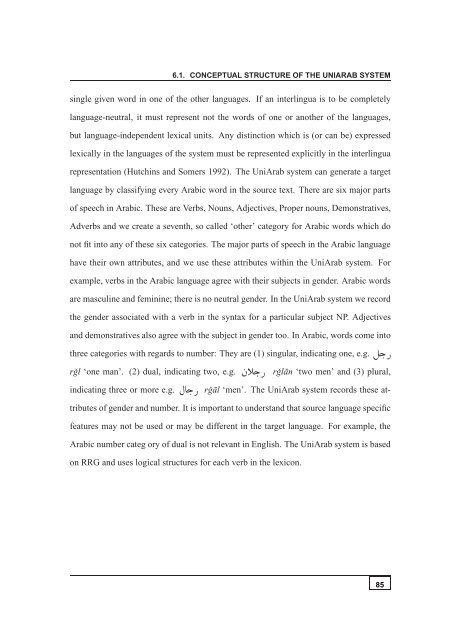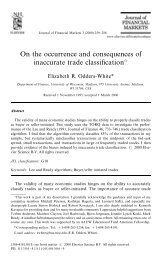A generic framework for Arabic to English machine ... - Acsu Buffalo
A generic framework for Arabic to English machine ... - Acsu Buffalo
A generic framework for Arabic to English machine ... - Acsu Buffalo
Create successful ePaper yourself
Turn your PDF publications into a flip-book with our unique Google optimized e-Paper software.
6.1. CONCEPTUAL STRUCTURE OF THE UNIARAB SYSTEM<br />
single given word in one of the other languages. If an interlingua is <strong>to</strong> be completely<br />
language-neutral, it must represent not the words of one or another of the languages,<br />
but language-independent lexical units. Any distinction which is (or can be) expressed<br />
lexically in the languages of the system must be represented explicitly in the interlingua<br />
representation (Hutchins and Somers 1992). The UniArab system can generate a target<br />
language by classifying every <strong>Arabic</strong> word in the source text. There are six major parts<br />
of speech in <strong>Arabic</strong>. These are Verbs, Nouns, Adjectives, Proper nouns, Demonstratives,<br />
Adverbs and we create a seventh, so called ‘other’ category <strong>for</strong> <strong>Arabic</strong> words which do<br />
not fit in<strong>to</strong> any of these six categories. The major parts of speech in the <strong>Arabic</strong> language<br />
have their own attributes, and we use these attributes within the UniArab system. For<br />
example, verbs in the <strong>Arabic</strong> language agree with their subjects in gender. <strong>Arabic</strong> words<br />
are masculine and feminine; there is no neutral gender. In the UniArab system we record<br />
the gender associated with a verb in the syntax <strong>for</strong> a particular subject NP. Adjectives<br />
and demonstratives also agree with the subject in gender <strong>to</strong>o. In <strong>Arabic</strong>, words come in<strong>to</strong><br />
three categories with regards <strong>to</strong> number: They are (1) singular, indicating one, e.g. <br />
rˇgl ‘one man’. (2) dual, indicating two, e.g. rˇglān ‘two men’ and (3) plural,<br />
indicating three or more e.g. rˇgāl ‘men’. The UniArab system records these at-<br />
tributes of gender and number. It is important <strong>to</strong> understand that source language specific<br />
features may not be used or may be different in the target language. For example, the<br />
<strong>Arabic</strong> number categ ory of dual is not relevant in <strong>English</strong>. The UniArab system is based<br />
on RRG and uses logical structures <strong>for</strong> each verb in the lexicon.<br />
85
















